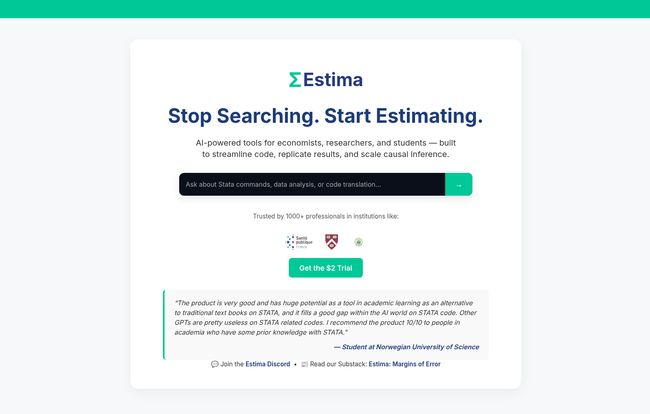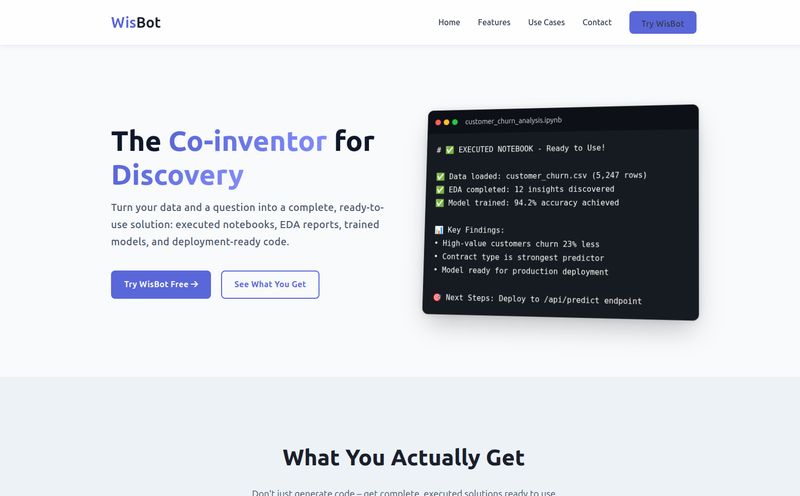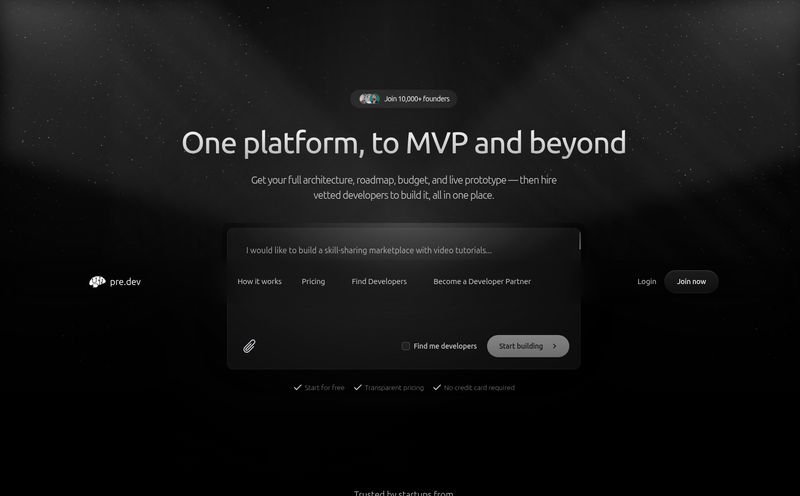If you've ever spent a Saturday night staring at a Stata do-file, whispering sweet nothings to the command line and praying your `merge 1:m` command doesn't explode, you're my people. For years, we've watched from the sidelines as our colleagues in the Python and R camps got all the shiny new AI toys. GitHub Copilot, fancy new libraries... meanwhile, we were stuck sifting through decade-old Statalist forums to solve an obscure error code. It felt a bit, well, archaic.
So when a tool like Estima from Stat.ai pops up on my radar, claiming to be an AI-powered assistant specifically for economists, researchers, and students using Stata, my inner skeptic raises an eyebrow. But my inner, sleep-deprived grad student alter-ego gets a little flutter of hope. Another tool promising to make our lives 10x easier? Sure. But this one... this one feels different. It's built for us.
I’ve been in the SEO and traffic game for a long time, and I've seen countless apps promise to revolutionize a workflow. Most of them are just repackaged fluff. But the tagline here—"Stop Searching. Start Estimating."—hit a little too close to home. So, I decided to take a look.
So What Exactly Is This Stat.ai / Estima Thing?
Think of it as an AI sidekick that's fluent in Stata. The platform, which you'll find at statagpt.com, is built to streamline the parts of data analysis that make you want to tear your hair out. It’s not about replacing the analyst (that's you). It’s about getting rid of the tedious grunt work so you can focus on the actual thinking part—the econometrics, the theory, the interpretation.
It's designed to help you write code from plain English prompts, replicate results from other papers without a week of debugging, and even translate code from those other languages. It’s aiming to be the bridge between your research question and a clean, executable do-file.
The Features That Actually Matter
Alright, let's get into the guts of it. A platform is only as good as its features, right? Here’s what stood out to me.
The Stata GPT: Your On-Demand Research Assistant?
This is the main event. You have a task, but you're blanking on the exact syntax. Maybe you need to generate a new variable based on complex conditions or run a specific type of regression with robust standard errors clustered at a certain level. Instead of opening five browser tabs and a textbook, you just... ask. In plain english.
I've always felt the biggest barrier in Stata isn't the logic, it's the memorization of its sometimes-quirky syntax. This feature acts like a senior RA who never gets tired of your questions and never needs coffee. It’s a massive time-saver, especially for those commands you only use twice a year but are absolutely critical when you need them.

Visit Stat.ai (Estima)
Estima Bridge and The End of the Code Language Wars
This is huge. If you've ever tried to collaborate on a project with someone who lives in RStudio, you know the pain. You're constantly emailing snippets back and forth, trying to manually translate a `dplyr` pipe into a series of `egen` and `bysort` commands. It’s a nightmare.
The Estima Bridge promises to translate code between Stata, R, and Python. For replicating studies, this is a godsend. No more trying to decipher someone else's poorly commented R script from a published paper's supplementary materials. In my experience, this feature alone could justify the cost for a research team. It's not just about convenience; it's about making research more open and reproducible. A genuinely noble goal.
Scaling Causal Inference (For the Data Nerds)
Now, for the heavy hitters. The platform talks about scaling causal inference. This is less for the student running their first OLS and more for the researcher wrangling massive panel datasets for a difference-in-differences or RDD analysis. The idea is to make these complex, computationally intensive tasks more efficient. While I haven't stress-tested this with a petabyte of data, the promise of streamlining these high-level analyses is incredibly appealing. It’s the kind of thing that can turn a week of computation and coding into a day or two.
A Balanced Look: The Good, The Bad, and The AI
No tool is a silver bullet. I’m an optimist, but I’m a realistic one. Here's my honest breakdown.
Why I'm Genuinely Impressed
The time-saving aspect is undeniable. It's the most obvious benefit. But beyond that, it's a fantastic learning aid. For beginners, it helps bridge the gap between their research question and the actual code, improving their learning curve. For experienced users, it's all about efficiency and reducing cognitive load. You can stay focused on the 'what' and 'why' of your analysis, not the 'how' of the code. The testimonial on their site from a student at the Norwegian University of Science rings true—it fills a real gap that generic tools like ChatGPT, which often spits out outdated or just plain wrong Stata code, can't.
Where I Have Some Reservations
First, it’s a subscription service. We're all used to paying for software, but it's a factor to consider, especially for students on a tight budget. Second, the output is only as good as the AI model behind it. AI can be confidently wrong, and you still need to have enough Stata knowledge to spot a weird result or a nonsensical line of code. This tool is a powerful assistant, not a replacement for your brain. It won't teach you econometrics, and you shouldn’t trust its output blindly. Always check the code.
Let's Talk Money: The Stat.ai Pricing Plans
So, what does it cost to get this AI assistant on your team? The pricing seems pretty reasonable, especially for the value it offers. They've got a few tiers.
| Plan | Price | Key Features |
|---|---|---|
| Free Trial | $0 | 15 Credits per month to test the waters. |
| Starter | $5 / month | 100 Credits per month. A special offer that will go up to $10. |
| All you can code | $19 / month | Unlimited credits. Access to everything. |
| All you can code (Annual) | $136 / year | Same as the monthly AYCC, but with a hefty 40% discount. |
My take? The Free Trial gives you no excuse not to try it. The Starter plan at $5 feels like an absolute steal for a student or researcher who needs occasional help. That’s less than a couple of lattes. For heavy users, research departments, or anyone on a tight deadline, the All You Can Code plan makes a ton of sense. The annual discount is pretty significant, too.
Who Is This Really For?
Let's cut to the chase. Who should sign up right now?
- The Overwhelmed Grad Student: Absolutely. This is your new best friend for coursework, problem sets, and your dissertation. It'll save you hours of frustration.
- The Professor on a Deadline: Yes. Speed up your workflow, simplify replication, and spend more time writing and less time debugging.
- The Government or Corporate Analyst: If you live in Stata, this is a professional development tool that pays for itself in a single afternoon of saved work.
Who might not need it? The casual user who only opens Stata once a semester to run a simple `regress` command. This tool is built for people who are serious about their data analysis in Stata.
Final Thoughts: Is Stat.ai Worth the Hype?
Look, the future of any technical work, including data analysis, is going to involve AI. It’s just a matter of how. Stat.ai and Estima feel like a massive step in the right direction for a community that has been underserved by the AI boom. It's not magic, and it requires an intelligent user to wield it effectively.
But it's a powerful, specialized, and thoughtfully designed tool that solves real, painful problems for Stata users. It’s like the developers actually used Stata and knew exactly what infuriates us. For me, that's more than enough to be optimistic. I think I'll be keeping my subscription.
Frequently Asked Questions
- Is Stat.ai completely free to use?
- It has a free trial tier that gives you 15 credits per month, which is great for trying it out. For more extensive use, you'll need to subscribe to one of their paid plans.
- Can this tool replace learning Stata from scratch?
- No, and it's not meant to. Think of it as a super-smart assistant or a pair of programming glasses. It helps you code better and faster, but you still need to understand the underlying statistical concepts and be able to verify that the code it produces is correct for your analysis.
- How is this better than just using a generic AI like ChatGPT for Stata code?
- Specialization is the key. General AI models are trained on a massive, messy dataset of internet text. They often produce Stata code that's outdated, inefficient, or just plain wrong. Stat.ai is specifically fine-tuned for Stata, leading to much more accurate and reliable code generation.
- What is the Estima Bridge feature?
- Estima Bridge is the platform's tool for translating entire code files or snippets between different statistical programming languages, namely Stata, R, and Python. It's designed to make collaboration and study replication much easier.
- Is my research data secure when using Stat.ai?
- Data security is a huge concern in research. While you're primarily sending code prompts, not entire datasets, it's always best practice to review the platform's privacy policy and terms of service. For sensitive data, the best approach is to use the tool to generate code syntax and then run it on your own secure machine.



